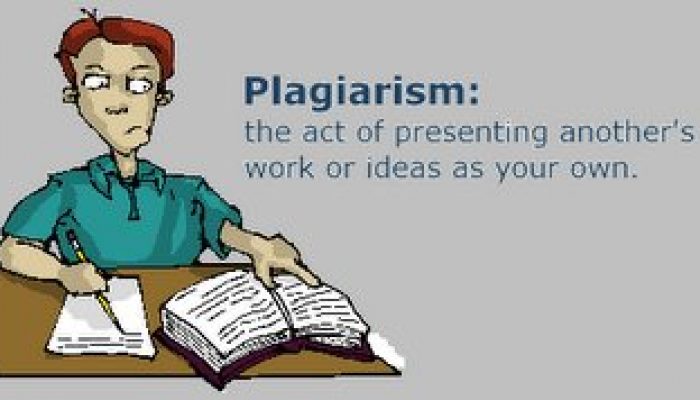
Tom Gleeson and Matt Currell (just to be clear about our sources…header image from http://iditis.blogspot.ca/2006/03/plagiarism-lesson-learned.html)
Plagiarism is a clear contradiction of scientific values and practice. Although no universal definition of plagiarism exists, a useful working definition is the wrongful appropriation, stealing and publication of another author’s language, thoughts, ideas, or expressions and the representation of them as one’s own original work (wikipedia). Plagiarism in our digital world can be too easy – although journals have stepped up on electronically detecting and policing plagiarism (Nature, 2010), there is evidence that plagiarism remains depressingly common (Science and Engineering Ethics, 2015). A case of documented plagiarism in the hydrologic sciences offers a number of lessons about how every one of us has multiple roles in making hydrogeology free from plagiarism.
An extensive investigation and review by the Kansas Geological Survey and the University of Kansas concluded that seven papers written by Marios Sophocleous contained extensive plagiarism and self-plagiarism. Yet some of these plagiarized papers are still routinely cited – for example, Sophocleous (2002) has been cited >500 since the public censure in 2013. The detailed report of the detection and investigation of this plagiarism as well as the response by journals and suggestions on paths forward was written by Jim Butler: Draft Report on Plagiarism.
To get a better sense of the style and scale of the plagiarism it is useful to examine a marked up version of Sophocleous (2002) – a highly cited paper on groundwater surface water interactions: Sophocleous_GW-SW HJ Journal 2002 KGS Analysis for distribution.
The University of Kansas requested four journals to retract seven different papers published from 2000 to 2012. Although there are different forms and severity of plagiarism, we concur that this is a clear and unambiguous case of plagiarism, and is totally unacceptable.
Retraction Watch wrote useful summaries of the varied response of journals to this request for retraction: Groundwater and Natural Resources Research retracted articles (Retraction Watch post) while Journal of Hydrology and Hydrogeology Journal refused to retract (see Retraction Watch post; Hydrogeology Journal editorial and Journal of Hydrology editorial which usefully lists original sources but unfortunately is behind a paywall). The articles were not retracted from Hydrogeology Journal because 1) “the reference from which the material was copied verbatim is given close by in the text by Sophocleous” implying “he was giving credit to the previous authors from which he copied, and not hiding the fact that the material was not his own.” and 2) the articles are highly cited which shows “clear value to the scientific community” (Hydrogeology Journal editorial). There are differing levels of plagiarism (including clear plagiarism, minor copying or redundancy) recognized by the Committee of Publishing Ethics which offered advice to Hydrogeology Journal and Springer on this case but the argument that the number of citations should have anything to do with whether a plagiarized article is retracted is spurious and irrelevant, and sets a dangerous ethical precedent. When popularity is considered to absolve the need for methodological rigor, and when it trumps the motivations and ethics behind our actions, we are not in a good place as a profession (or a society). Cliff Voss, Hydrogeology Journal Executive Editor, also clarified recently that he considered attaching an editorial to the non-retracted articles a better lesson in plagiarism since the plagiarized articles are then more visible for everyone to learn from, rather than just disappearing if they were retracted.
Part of the challenge of this case is that most references in the papers were not identifiable by plagiarism detection software because many were local reports or old references that are absent from the widely used database systems as explained by the Journal of Hydrology editorial. Instead, the assessment by the Kansas Geological Survey consisted of identifying possible copied passages and then electronically searching potential sources. The Kansas Geological Survey has importantly offered to make their analyses of the papers discussed in the Hydrogeology Journal editorial available upon request.
In a strange twist of fate, one of us (Tom) collaborated with Marios on two papers on groundwater sustainability as a postdoctoral fellow – totally oblivious to the pending investigation into his papers. For both groundwater sustainability papers (Gleeson et al 2010; Gleeson et al 2012), Tom lead the writing with a number of other coauthors editing and contributing text – Marios largest contribution was to the ‘High Plains Aquifer’ section of Gleeson et al. 2012. Given the above limitations of plagiarism software, Tom conducted his own investigation of this section, going line by line through and electronically searching potential sources for each line. He did not find any lines that had clearly come from other sources and found that the referencing was proper and consistent at the end of sentences throughout this section.
The public censure, the above report from Jim Butler, and the response from journals reinforces a number of lessons about how every one of us has multiple roles to play in rooting out plagiarism. So this leads to…
How can we make hydrogeology free from plagiarism?
The report from Jim Butler attached above has a number of useful recommendations for reviewers, readers, editors, professional societies and publishers, and universities/research institution that could help make hydrogeology free from plagiarism. We echo all of these important recommendations and add a few additional recommendations from my own reflections and experience:
For anyone writing academic articles:
- Be vigilant about plagiarism in papers that you are citing and stop citing papers that have documented plagiarism. In the case of the papers part of a public censure for plagiarism from University of Kansas, instead request marked up version from the Kansas Geological Survey and cite the original sources of text; this is more ethical and will lead you to some interesting old literature that deserves citing.
- Be vigilant about plagiarism with your own writing and the writing of your coauthors – now every time we start to copy any text we stop, and consider whether this could potentially lead to plagiarism.
For educators – use this case as an example to talk about plagiarism in your classes. We have done this tactfully a number of times in senior undergraduate and graduate classes.
We all need to work hard to make hydrogeology free from plagiarism and we all have multiple roles in this as writers, reviewers, editors, supervisors, coauthors etc. – we hope this article will help in some small way encourage us all to take the high road. We conclude with a few open questions that touch on deeper issues about the ethical challenges in the modern academic system (these can evolve into future posts if there is interest):
- What are the incentives and pressures which drive people to plagiarize like this case? Is there a problem with the system of rewarding researchers who publish large numbers of articles (e.g., through improved chances of securing tenure and/or academic promotion)?
- How can we properly acknowledge the source(s) of our ideas when there is so much literature out there which overlaps and recycles old ideas?
- How can we stop the tide of what Frank Schwartz termed ‘Zombie Science‘ (research that makes little original contribution), while still giving early career researchers opportunities to learn and apply established techniques and publish their work even if it is not particularly ground-breaking


Jim Roy
I applaud you Tom for sharing this blog on an important, often-neglected, yet sensitive, issue. It is also a complicated (nuanced) topic, especially when it comes to self-plagiarism, that deserves substantial discussion during the apprenticeship of upcoming scientists. I hope everyone gets their students to read this, as a start at least. And yes, all researchers must be vigilant in their reviewing and writing; over-ambition and laziness should not erode the integrity of our science.